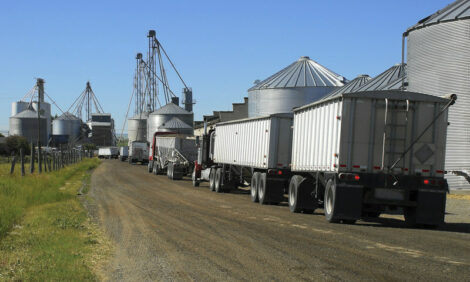



Pork Commentary: World Pork Expo Preview
CANADA - This weeks North American Pork Commentary from Jim Long.This week is the World Pork Expo. We will be there just east of the varied industry building in the Genesus tent. This is the 20th year of the World Pork Expo. Makes us feel old when we realize that we have been at all 20. Over those twenty years, a generation, the pork industry has had a radical makeover. Consolidation, scale of producers, multi-site, genetics, health, environment, animal rights, etc have all been part of a massive change. The next twenty years? Who the heck knows? It will be different. That’s all we can speculate. When we look back at the last twenty, we realize it’s good not to know the future. The last twenty was daunting in the many changes and adjustments we had to respond to. It’s best to stay tuned. The next twenty will be interesting and challenging. Part of our future preparation is get off the farm and out of the office. The World Pork Expo is the largest collection of industry participants and spending the time to see what’s happening and talking to as many participants as possible will give a wider perspective on industry direction. Make the time to get to the Expo. It’s an investment in your future.
Breeding Herd
The breeding herd is declining at a significant speed. Why?
- In the first four months of the year, the US sow slaughter is up 92,000. Last year, the USDA Hogs and Pigs Report indicated that the breeding herd increased in the 6 months December 1 to June 1 by 33,000 sows. That indicates to us a minimum 60,000 US herd decline since January 1st.
- The Canadian government sow kill is underway. Sows are being rendered. These sows are not in official slaughter statistics. An anecdotal story. 2,400 sow Manitoba unit, farrow to wean, signed up a few days ago. All sows already dead. Farm cannot have sows for three years. No more early wean pigs as of now. Quick cut of production.
- Gilt slaughter data gathered by the University of Missouri shows that gilts have accounted for 49.9% of total barrow and gilt thus far in 2008, versus 49.3% last year. A gilt slaughter rate of 49.4% to 49.5% suggests a stable breeding herd, so these data support that sow numbers are falling as well.
Some Arithmetic
US slaughter from Jan 1 to May 10, 2008 was 40,220 million. If we use 49.5% gilt slaughter as equilibrium and then calculate a .4% factor to reflect the 49.9% number that the University of Missouri indicates for year to date 2008, 40.220 million head x .4% would suggest 160,880 more gilts to slaughter from January 1 to May 10 than equilibrium. Of course, this is not absolute. The low price of sows in the first four months of 2008 has encouraged producers to keep sows another parity and ship gilts or just not buy them.
Bottom-line - More sows to slaughter and less gilts being retained. It’s not hard to calculate a US herd decrease since January 1 of a minimum 70,000 to a high of 120,000. Canada will be down 80,000 to 100,000. Canada-USA breeding herd decline since January 1 is 150,000 – 220,000. There will be significantly fewer pigs in the coming months. Couple this with global swine production decline and lower chicken and beef production. Prices have tremendous upside.
Other Observations
- How many fewer off pigs do not leave farrowing? Nursery? With prices at crisis levels the last few months, it was idiotic to try to feed poor and off pigs. They were terminated? How much will this cut production? One cull buyer tells us that there has been significant decline. If so, we will have fewer hogs and less pork coming to market. Price supporting.
- Hog prices have increased significantly in Mexico, reaching 18 pesos a kilogram (80¢ US liveweight a lb). After months of huge losses, Mexican producers are getting some relief. Feed prices though are high with corn around $8.00 a bushel. Mexico is expected to increase corn production in 2008 from 21.6 to 25 million tonnes. The same scenario we see everywhere in the world. High grain prices are increasing global production. High hog prices in Mexico are due to lower domestic supply and higher US prices make imports more expensive.
- Spot early wean pigs are currently trading around $15.00. We expect that by November-January spot early weans will be $60.00 plus. Supply will be down at that time, lean hog futures six months out will be 90¢ lean plus. Those finishers who broke supply contracts using lame excuses such as COOL will be ending up paying up big time. We are not predicting it but we will not be surprised if spot early wean pigs exceed $80 sometime in 2009. Supply-demand, it trumps all other theories.
- The USDA announced last week that 24 million acres (about 40,000 square miles) of conservation land will be allowed to be used for hay or grazing without penalty. The USDA estimates that this could be up to 1.2 million tonnes of hay equivalency. Not sure what all this means but we think it’s part of the government’s recognition that high food prices could become a huge political issue. Certainly, if the 1.2 million tonnes of hay becomes reality, that diminishes the need for grain. Greater supply always cuts prices.
Markets
Iowa-Minnesota lean hog prices took a big hit last week, dropping from 79¢ to 72¢ Friday to Friday. The short week due to Memorial Day gave the packers leverage. We expect prices to rally quickly. Supply is declining, pork cut-outs are over 80¢ and packers will restart the chase. Futures held over the week, with June closing Friday at 77.75. Hog supply last week, year over year, was about 6% higher than a year ago. It appears that weekly increases that were 10%, year over year, are gone. Supply is dropping.
Bill 17
Manitoba’s Bill 17 that stops the building of new swine barns is a direct attack on the Hutterite and Mennonite’s that comprise 86% of all swine producers in the area. The bill effectively prevents building in an area encompassing 75% of Manitoba’s crop land. Mennonite families who wish to grow hog production in their own communities will be prevented by this ill-advised, draconian legislation. They will not be able to build by their family, by their church; they will be forced to move large distances or out of the province to pursue their vocation. Hutterites live in communities. When they wish to build a new community, one of the centerpieces of their development is the building of a swine farm. Preventing new swine buildings will, in essence, push all new Hutterite communities out of most of Manitoba. Is this legislation an environmental law? We think not. It’s a charade by the socialist government of Manitoba to drive conservative, church-focused, hard working people of our society out of the province or into its fringes. The environment has become a mantra for social engineering. This is not environmental legislation by a direct attack that is an affront to human rights. It’s prejudice. It’s anti-religious. It’s offensive to any person who believes in freedom and the right to commerce. If ever there was an issue that needs fighting, this is it. It appears that the socialist government of Manitoba wants to drive the Mennonite and Hutterite communities from the province. It’s the worst king of social engineering.









